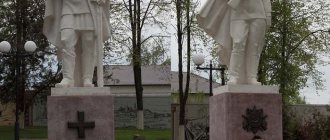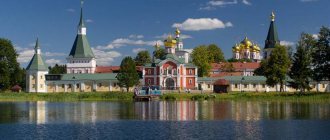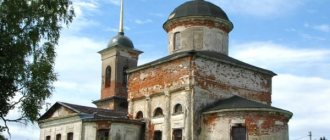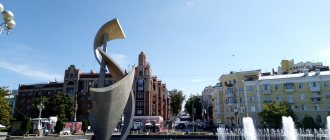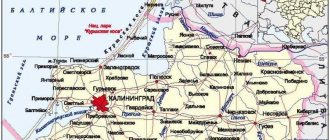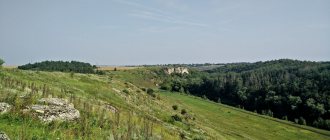Vitebsk is an ancient Eastern European city. It stands at the confluence of two rivers - the Western Dvina and Vitba. He got his name from the latter. Vitebsk is more than a thousand years old - according to urban legend, its founder was Princess Olga.
It became part of the Russian Empire in 1772 after the partition of Poland, and before that it belonged to the Grand Duchy of Lithuania, then to the Polish-Lithuanian Commonwealth. Now Vitebsk is the regional center of the Republic of Belarus.
Today Vitebsk is famous for its arts festival “Slavic Bazaar”. In addition, the city is the birthplace of Marc Chagall, an avant-garde artist.
Many interesting places around Vitebsk and what other cities in Belarus are a must-see: in a large guide to the country.
Vitebsk: history of the city
Vitebsk is one of the oldest cities in Belarus. It was founded by Princess Olga in 974, but the first mention of the city in chronicles appeared in 1021. Its favorable location on 3 rivers (Western Dvina, its tributary Vitba and Luches) influenced the rapid development of various crafts, industries, trade and led to population growth. By the way, the name of the city comes from the Vitba River. At the end of the 12th century, Vitebsk, under the control of the Polotsk princes, developed into a full-fledged trading city. During this period, they began to build the first church made of stone - the Holy Annunciation.
In the 16th century, the city became the center of the Polish-Lithuanian Commonwealth, since the last Slavic prince gave his daughter in marriage to the son of the Grand Duke of Lithuania Gedemin. After this, this area often became a springboard for military operations. In the 17th century, the Jesuits came to Vitebsk and built their own churches and schools. Orthodoxy was prohibited until the end of the 18th century, when the city became part of the Russian Empire as a result of the division of the Polish-Lithuanian Commonwealth.
In the 20th century, the development of Vitebsk accelerated, it became a cultural and creative center, as well as a place of active artistic life. Here M. Chagall opened the People's Art School, which graduated many famous artists of various directions, for example, K. Malevich and Yu. Peng. In addition, the Theater of Revolutionary Satire and the People's Conservatory were opened in Vitebsk.
Vitebsk at the beginning of the twentieth century
In 1924, Vitebsk became part of the BSSR, and in 1938 it became a large regional center, where over 200 enterprises operated.
The city suffered greatly during the Great Patriotic War: 90% of the buildings were destroyed, most of the residents were shot by the Nazis or taken to concentration camps and hard labor. But after the war, Vitebsk was rebuilt again, and the remaining architectural monuments were restored. Currently, it is one of the largest industrial centers in Belarus and has a population of 369 thousand people.
Take a selfie with Marc Chagall
Marilyn Monroe, John Lennon, Yuri Gagarin and Salvador Dali on the streets of Vitebsk are not fantasy, but reality. Vitebsk courtyards are famous for a series of portrait drawings on the walls and transformer boxes of the city. “Star” graffiti is reverently loved by both tourists and residents of Vitebsk. These drawings appeared thanks to the artists of the group Youfeelmyskill and Myhoodisgood. You can take a selfie with the star in many city courtyards, the closest to the city center is a portrait of Marc Chagall on Suvorov Street, 36, Evgeny Leonov and Shurik in the courtyard of Gogol Passage, 6A, Salvador Dali on the wall behind the Belarus shopping center.
Oddly enough, you will find a portrait of Kazimir Malevich on Marc Chagall Street, not far from the museum of the Vitebsk People's Art School.
By the way, for lovers of urban art and “green” themes, we can offer another route through city drawings. The adventures of touching and open-to-the-world tree people were captured on the walls of Vitebsk by an artist under the pseudonym Ancestor.
You can find these drawings near the bridge in the courtyards of Pravda Street and on Oktyabrskaya Street, 2.
How to get to Vitebsk from Russia?
Citizens of the Russian Federation need only present a passport to cross the Russian-Belarusian border. You can get to Vitebsk from Russia by train, bus and car. There are no air connections between this city and Russia. A bus ticket is the cheapest option, plus it travels faster than a train and will take you to your destination in 8 hours. But you can take a ride and get there inexpensively and comfortably. The fact is that many residents of Vitebsk work in St. Petersburg and Moscow, so they often go home on weekends. You can travel with them in both directions for an affordable price.
If you travel by train, the best option would be a night route: in the evening you can get off in Moscow or St. Petersburg, and in the morning come to Vitebsk and devote the whole day to sightseeing.
Trains from Moscow and St. Petersburg to Vitebsk take only 9 hours.
There is only one railway station in the city. From here to the center you need to travel just three stops on any bus or trolleybus. And if you are light, it is more advisable to walk this route.
Railway station in Vitebsk
By car you can get to Vitebsk in 6.5 hours from Moscow and in 8 from St. Petersburg. From the capital you should take the M1 highway, and from Northern Palmyra the optimal route is the E95 road.
Feel like part of the old city among the “red houses”
Vitebsk is famous for its red brick houses. You are familiar with them if you watched the film “Chagall-Malevich”. In such courtyards you can feel the atmosphere of the old city. Much of authentic Vitebsk, as it appeared on black-and-white photographs and postcards, was destroyed during World War II. Now some of the Vitebsk red houses have been restored, but many still remain in their original form.
You can look at the red brick houses in Vitebsk on Chekhov, Griboyedov streets, as well as in the area of the railway station and Oktyabrskaya, Revolyutsionnaya, Dimitrova streets. You will definitely pay attention to them: the “red” houses of the 19th-20th centuries stand out against the background of other buildings, like Suprematist paintings at an exhibition of landscapes. But we especially recommend you the courtyard on Chekhov Street with patterned latticework and brick columns. And pay attention to the forged roses on the eaves of the apartment building!
Slavic Bazaar in Vitebsk
Vitebsk is famous for its music festivals, which are organized with the aim of bringing together people from countries that are very similar culturally and historically. Fans of noisy public events should come here in July, when concerts, performances, exhibitions and competitions with prizes, etc. are held.
Night Slavic Bazaar
The main events take place in the summer amphitheater, which has original architecture and is considered the heart of Vitebsk. This structure has no analogues in the world and has excellent acoustics. Its last reconstruction was carried out in 2007, thanks to which the number of seats in the hall increased to 6200. To prepare for the performance, a building of 4 floors was built - hotel rooms, dressing rooms, cafes, etc. are located here.
Address: Vitebsk, st. Frunze 13a.
During the period when there is no Slavic bazaar, you can walk around the amphitheater, enjoy the silence, the noise of trees and birdsong, and stroll along picturesque paths.
Reviews from tourists
- Alexander, Saratov
Vitebsk is a clean and beautiful city. People here respect their history and care about preserving their cultural heritage. I liked the fact that the city has many museums and restored historical and architectural monuments.
- Daria, Ufa
I like the fact that the city is surrounded by greenery. There are many fountains in parks and squares. The city also has several rivers and reservoirs with picturesque views.
- Igor, Syzran
I came here a year ago and received a lot of positive impressions.
There are many very beautiful churches in Vitebsk, unfortunately, I didn’t even have time to see them all. I also went to the Slavic Bazaar, it was indescribable. I highly recommend coming here, especially in the summer. Vitebsk is a city with amazing architecture and interesting sights.
Most of the sights of Vitebsk cannot be seen in 1 day, but in 2 days it’s quite possible. The city is perfect for a weekend getaway and you'll definitely find something to see.
Assumption Cathedral in Vitebsk
Mention of the Assumption Cathedral appeared at the beginning of the 15th century. Three centuries later, additional Uniate church buildings were added to it. However, in the 30s of the last century, the cathedral was blown up and for a long time only ruins remained at this place. In 2011, a new temple was built in the Vilna Baroque style, which was widespread throughout the Polish-Lithuanian Commonwealth during the period of the end of the existence of this country.
A beautiful winding staircase leads to the Assumption Cathedral, the style of which echoes the architecture of the temple. The pride of the cathedral is the largest bell in Belarus, weighing 5 tons. The presented religious building is located on a hill called Assumption Hill. Near the cathedral there is a convenient observation deck from which tourists and residents of the city can enjoy a wonderful view.
Assumption Cathedral
Address: Vitebsk, st. Commissioner Krylov 9. Opening hours: daily from 8.00 to 20.00.
View the city from above
Many people remember the local town hall, but few know that from here you can see the whole of Vitebsk at once.
From edge to edge, the city will open up to those who climb to the observation deck. This kind of entertainment is well suited for adventure lovers: climbing to a height of about 40 meters is not easy, you have to go up steep narrow stairs, where sometimes it’s even scary to look down.
From the top there is an impressive view of the city center, the domes of the Resurrection Church and the Assumption Cathedral, the roofs of old houses on Suvorov and Tolstoy streets. This is a wonderful panorama for the most memorable photographs. You can visit the observation deck at the town hall alone or in a group of up to 10 people at a time; a ticket costs 6 rubles.
Church of St. Barbara in Vitebsk
The church was erected in 1785 and then remodeled at the end of the 19th century in the neo-Romanesque style. In Soviet times it was not destroyed, but was used as a warehouse. Restoration work was completed in 1993. Currently, the church is used by the Vitebsk diocese.
Church of St. Barbara
Address: Vitebsk, st. Leningradskaya 27. Opening hours: daily from 10.00 to 18.00.
Vitebsk Tram Museum
The museum has been operating since 1966 thanks to the factory trade union committee. The periods of development of urban electric transport in Russia and Belarus, starting from 1896, are displayed here. The museum is constantly replenished with valuable exhibits, which are also collected in Russia and Ukraine. There is constant cooperation with the archives of Moscow, St. Petersburg, Germany, France and Belgium.
The museum presents not only historical documents, but also models of tram cars from different times, the uniform of conductors and their accessories.
Vitebsk Tram Museum
Address: Vitebsk, 5th st. Frunze 7. Opening hours: Mon-Fri from 8.00 to 17.00.
Entertainment
"Slavic Marketplace"
Address: main festival site - st. Frunze, 13a Website: fest-sbv.ru
International Arts Festival. It was first held in 1992. During the collapse of the Soviet Union, it was called upon to revive the community of cultures of the Slavic peoples. The founders were non-profit private organizations from Belarus, Russia and Ukraine.
The main venue of the festival is the summer amphitheater, and the main competition is for pop song performers. Winning the competition is considered a prestigious award.
The XXVIII International Festival “Slavic Bazaar in Vitebsk” will be held from July 9 to July 17, 2022.
Zoo
Address: st. Kupala, 17 Telephone: Opening hours: Tue-Fri 10:00-17:00, Sat, Sun 10:00-18:00 Cost: under 3 years old - 0, from 3 to 12 years old - 3 bel. r., over 12 years old - 4 bel. R.
Located in the city center. Storks and geese roam freely around the area.
There is a Red Book animal of the Republic of Belarus in the zoo - the bison Borka.
Museum-estate of I. E. Repin “Zdravnevo”
15 km from Vitebsk there is the mysterious estate of the artist Ilya Repin “Zdravnevo”. Nature here has a unique energy that inspires you to paint a unique masterpiece or take a picturesque photo.
The bank of the Dvina in this area is covered with exposed layers of dolomite, which, according to legend, create the amazing energy of these places. The only disadvantage of this museum is its inaccessibility. Direct routes operate only 4 days a week, twice a day.
Address: Vitebsk district, village. Ruba. Opening hours: Tue-Sun from 9.30 to 17.30.
The museum exhibits copies of the most popular masterpieces of the famous artist, his furniture and household items.
Attractions in the surrounding area
Berezinsky Biosphere Reserve
Coordinates: 54.741000, 28.320018 Address: Vitebsk region, Lepel district, Domzheritsy, st. Tsentralnaya, 3 Website: www.berezinsky.ru How to get there: minibus from the bus station in Minsk and Vitebsk to the village of Domzheritsy
The reserve has been operating for almost 100 years. You can come here and watch animals in natural conditions. You can pre-book an excursion, for example, to a forest zoo, where wild animals live in large enclosures.
Gazebos are available for relaxation. There is the Serguch Hotel with comfortable rooms and a restaurant that serves game caught in the hunting grounds next to the reserve. In the Forest Fun complex on the territory of the reserve you can do extreme sports. There are suspension bridges and rope crossings.
For walking, you can rent bicycles, electric cars, and ATVs. During the warm season, there are walking tours on the territory of the reserve. There is an opportunity to go horseback riding or kayak along the rivers and lakes of the reserve.
Governor's Palace
The mansion was erected at the end of the 18th century and belonged to the Kudinovich nobles. In 1806 it became the residence of the Governor-General, and 5 years later the southern building was added to it. The building was built in a neoclassical style with modernist elements.
From 1811 to 1821, the governor, Duke Alexander of Württemberg, the brother of Empress Maria Feodorovna, lived in the palace. In the summer of 1812, the French Emperor Napoleon I Bonaparte stayed in the building. After the war in the 19th century, many famous people temporarily lived in the palace, in particular the future Emperor Alexander II.
During the Great Patriotic War, the governor's palace was severely destroyed. After the war it was restored and the KGB has been located here for a long time. In the future, it is planned to create a museum in the mansion.
Governor's Palace
Dukhovsky roundabout
The Dukhovsky circle is a copy of the stone tower of the Lower Castle complex of buildings, erected by Prince Olgerd in the 14th century. In the 17th century, this building was destroyed and in its place a wooden octagonal tower was erected, which was later called the “Dukhovskaya Kruglik”. It was named after the Oven Church.
The modern tower was built by analogy with the structure of the 14th century. It has 5 levels, where there are exhibitions representing the history of Vitebsk and the Slavic Bazaar art festival. The first exhibition includes what remains of the real 14th-century tower: part of the foundation and elements of the defensive walls.
Dukhovsky roundabout
Discover non-standard Vitebsk space
If you are not attracted to the usual museums, then at 7 Tolstoy Street you can not just visit an exhibition hall, but find yourself in an alternative urban space. The local courtyard will greet you with a mural in the form of a painting by El Lissitzky and many strange objects, including a mirrored door and a chair on a high platform.
But the most incredible things can be found inside: in the art space on Tolstoy, 7 there is a hall with paintings instead of a floor and a porthole on the door, and the walls on the stairs are painted with reviews and messages from other visitors. Photo projects, contemporary art exhibitions and art objects - there is nothing permanent in this place, but there is definitely enough creative fervor. Cozy city festivals are often held in the courtyard of the art space, and a new museum dedicated to the famous Vitebsk inventor and photographer Sigismund Yurkovsky was recently opened in the basement.
Partisan Glory Park and Minai Shmyrev Museum
Under this name, this park does not exist for long, because until 2010 it bore the name of Lenin. Here you can walk in the shade of trees, sit on a bench, and go to the museum of Hero of the Soviet Union M. Shmyrev. It was created in 1969 in honor of the celebration of 25 years of the liberation of Belarus from the Nazi invaders. Near the museum there are artillery pieces, partisan dugouts and the “Rail War” exhibition.
Museum exhibits tell about the history of the partisan movement on the territory of Belarus; here are the personal belongings of Minai Shmyrev, the interior of his office, etc.
Exposition of the Museum of Hero of the Soviet Union M. F. Shmyrev
Address: Vitebsk, st. Chekhova 4. Opening hours: Tue-Sun from 10.00 to 19.00.
What else can you see in Vitebsk?
In addition to the listed attractions, Vitebsk has many beautiful picturesque places. For example, the city can boast of having the largest square in the country - Victory Square. Its length is 380 m. There are buildings around it from the 60-70s of the last century. In 1974, the square was decorated with a memorial in honor of the partisans and soldiers who resisted the enemy during the Great Patriotic War. It consists of three stone bayonets reaching into the sky.
Memorial on Victory Square
One of the most interesting streets in historical and architectural senses is the central Suvorov Street. It dates back to the XIV-XV centuries. There are many interesting buildings of the 19th and even several of the 18th centuries (Town Hall, shopping arcades) that have survived to this day. The most striking of them are: the former Nazymov mansion, a bookstore, a men's religious school, and former apartment buildings. Traveling along Suvorov Street you can come to the Partisan Glory Park.
Suvorov Street under the snow
Fans of artistic creativity in Vitebsk will not be bored, since in addition to the mentioned Art Museum and Repin’s estate, you can enjoy viewing paintings in the Vitebsk Center for Contemporary Art Art Space, located at st. Tolstoy, 7. Here are collected projects of modern trends by local artists.
Art space
Not far from the governor's palace on Putna Street is the M. Chagall Art Center. Once upon a time, a famous Vitebsk artist lived in the house, where an exhibition of his works and archival documents is now located.
Those who love nature and walks among shady trees can visit the Vitebsk Botanical Garden. It was created in 1919 thanks to the famous Vitebsk agronomist Sadovsky. The garden was intended for the study of botany by students of schools and higher educational institutions. Currently, the plant collection includes more than 2,200 species from different parts of the globe. The territory of the institution is about 4 hectares.
Botanical Garden of Vitebsk State University
Read the Master's thoughts on the city walls
If you are already near VNHU on Marc Chagall Street, then do not hesitate to walk through the local courtyards. Raise your head higher and you will see the Suprematist paintings that decorate the top of almost all local high-rise buildings. And in general, if you carefully walk around Vitebsk, you will notice how many paintings in the Suprematist style can now be found on the houses of this city.
And if you pay attention to the cozy old courtyards, the streets will speak to you in the words of the artist directly from the walls of houses and fences: if you like to catch the Master’s thoughts, you should walk along Marc Chagall Street.
Or go to Pokrovskaya, to the house-museum. Here, almost from the very beginning, poetic lines that the artist dedicated to Vitebsk stretch along the gray concrete fences.
And if you look into the Tent of David synagogue on Griboyedov Street, you can see reproductions of stained glass windows by Marc Chagall, which he painted for the Hadassah synagogue in Jerusalem.
Hotels and prices
The best time for walking around Vitebsk is from May to September. For those who do not like standing in lines and seeing heaps of people in cafes and restaurants, it is better not to come to Vitebsk in July, when the international festival takes place.
Most hotels and hostels are located in the central part of the city or nearby. When booking a hotel, it is better to rely on street names rather than the area. The central location is Suvorov, Lenin, Kalinin, Zamkovaya streets, Victory Square, the beginning of Frunze and Moskovsky avenues.
Important! The most popular and good location hotels are Eridan, Vitebsk, Luchesa, Zolotoy Telenok, as well as hostels H.O. and “On Oktyabrskaya”.
In Vitebsk, the cost of housing and food is relatively inexpensive. For a double standard room per day you will have to pay 1800-2200 RUR. RUB, for a single room - about 1600 RUR. rub. Lunch in a cafe alone will cost 300-400 rubles, but you can find a canteen where food will cost less.
Vitebsk has a large number of attractions for every taste. Art lovers are recommended to visit the Art Museum, Chagall Art Center, Repin's estate and Art Space. Those who want to deepen their knowledge about the period of the Great Patriotic War will go to the Partisan Glory Park and the M. Shmyrev Museum, as well as to Victory Square. Fans of ancient architecture will enjoy visiting the Town Hall, the Governor's Palace, the Church of St. Barbara, and the buildings on the street. Suvorov and other historical buildings. In general, Vitebsk is a city that is perfect for spending an ideal weekend.
Where to go for the weekend: Vitebsk
How to get there
It is better to get to Vitebsk by train. A ticket will cost 40,000 – 60,000 rubles. Feel free to choose a night flight - having left Minsk at 23:00 on Friday, you will be at your destination at 7:35 on Saturday. Just remember: on weekends, crowds of hungry students head home from the capital to eat their mother’s borscht, so it’s best to buy tickets in advance. Preferably within a week.
Where to stay
Close to the center is the H.O. , you can choose it as an overnight stay. Although you can also stay at the Vitebsk Hotel , Luches or the Golden Calf . Prices: 300,000 – 400,000 per night in a single room. Or you can rent a room at the Eridan and while away the night in the bed in which Pugacheva or worse slept - during the Slavyanka, the most famous celebrities spend the night here.
The first day. Dive
The best way to travel around Vitebsk is by minibuses - there are many of them, they run frequently, and they cost only 5,000 rubles. and, in general, they compensate Vitebsk residents for the lack of a metro. But only if you are immune to “Retro FM” and chanson: Vitebsk minibuses are so harsh that you fall out of every second car, mechanically singing something like “Eh, Zinka, Zinka, Zinochka” or “My bro, Marian.”
The trams in Vitebsk are especially good , among which there are still rattling representatives of Soviet times: riding on one of these across the bridge over the Dvina is so romantic!
It is best to start getting acquainted with the city from its historical center - the pedestrian Suvorov Street. Here is the main symbol of Vitebsk - the city hall . In addition, nearby are the most comfortable places where you can have a tasty and inexpensive snack.
For example, drink morning coffee and pie the Coffee House or the newly opened Biscuit Those who like to have a hearty breakfast can visit the Vitebsk Tavern , the menu of which includes not only a rich beer list, but also Lenten dishes. It’s best to devote Saturday to city tours, so get ready right away: you’ll have to walk a lot and for a long time.
Western Dvina, Luchesa and Vitba are the three main Vitebsk rivers. The latter gave the name to the city. In Vitebsk there is a fountain in the form of three not particularly attractive naked women - this is how the author saw the above-mentioned rivers. The fountain was built on the site of the Church of St. Anthony , which was blown up by order of the Soviet authorities in the 1940s.
By the way, Vitebsk suffered greatly during the fight against “opium of the people.” Today the Annunciation and Resurrection churches and the Assumption Cathedral . The latter floats out on a white ship to meet everyone who came to Vitebsk and from the station heads along the Kirovsky Bridge to the center.
Vitebsk was first mentioned in chronicles in 974. It is believed that it was founded by the Kiev princess Olga. However, the main historical character of Vitebsk is still Grand Duke Olgerd. Under him, the Grand Duchy of Lithuania significantly expanded its borders and flourished.
Who has never been to Vitebsk: for example, Napoleon. Rumor has it that he became infatuated with a Vitebsk woman and stayed in the city longer than planned, which subsequently led to the failure of his Russian campaign. The emperor stayed at the Governor's Palace (the building has survived to this day). There is also a monument to the victors in the War of 1812.
Just walk a couple of steps from the palace and you will find yourself at the entrance to the Vitebsk Zoo. But it’s better not to go there - you may have to treat the melancholy from what you saw with alcohol. And not just one day. So it’s better to go to the Assumption Cathedral. It is located on Uspenskaya Hill - a kind of observation deck in Vitebsk. From there you can go down the stairs to the Yakub Kolas National Academic Theater. Along the way, attention will inevitably be attracted by the dwarf Pushkin . Just walk a little to the left and you will find yourself at the building of the Vitebsk puppet theater “Lyalka”.
Chagall and company
The Marc Chagall Art Center is also located on Assumption Hill . Here you can find some of his works. The great artist is loved and revered in the city. In the fall of 2012, almost every creative person in the city tried on the image of a Vitebsk resident of the early 20th century, taking part in the filming of A. Mitta’s film “Chagall-Malevich” .
Zadvinye, the historical part of the city, is imbued with the spirit of Chagall. There are many houses-monuments of the 19th – early 20th centuries. They say that the center of Minsk was the same in its time. Here is also Pokrovskaya Street, on which the Marc Chagall House Museum .
The street doesn't look very good, to put it mildly; and in the museum, consider that only photographs remind you of the master. The guide will monotonously tell you that “little Mark usually lived in the corner, on the stove.” But it’s still worth visiting the museum, if only to pay tribute to the artist’s genius. And who knows, maybe the kind, sad eyes of a master will look at you from an antique mirror in one of the rooms.
Although every time has its heroes. the street artist Prodak (in the world - Maxim Samosevich) operates in the city Thanks to him, it is impossible to feel lonely in the city - his kind birds “hide” everywhere: under bridges, on the walls of residential and abandoned buildings, in courtyards and on playgrounds.
If you return to Suvorov Street and go up, sooner or later you will find yourself on Lenin Square. Vladimir Ilyich still stands opposite the Vitebsk Regional Philharmonic with his outstretched hand . However, in the Park of Partisan Glory named after Minai Shmyrev (located opposite the square) you will have a “meeting” with another, but much more pleasant one, Vladimir - Korotkevich , the legendary author of “Dzikaga Palyavannya of Karal Stakh”.
One of the symbols of the city is “Three Bayonets” - a majestic memorial complex in honor of Soviet liberation soldiers, partisans and underground fighters of the Vitebsk region, located opposite Victory Square. It is to him that grooms bring their brides on their wedding day, and lonely hearts of all orientations and religions bring hope of meeting their soulmate.
Night life
After taking a walk, you can get ready for an evening rest. There are enough places for cultural leisure in Vitebsk, but you need to make a responsible choice, otherwise you risk ending up in an establishment with leopard upholstery on the chairs and chanson as the background music.
We have enough good places. If you want to drink beer and smoke hookah, head to the Black Forest . “Zhuravinka” has live music, “Golden Calf” has excellent bowling alleys. Beer prices throughout the city are the same: 20,000–30,000 rubles. per glass.
Those who like to dance with students can go to Zebra ; No Limit and Planet clubs are of a slightly different class - designed for people with money. But keep in mind: the latter is known not only for its three dance floors, but also for its aggressive security. As for Energia , one of the largest clubs in Eastern Europe, it’s better to go there just for show. The club is famous for its uncomfortable dance floor, low-quality music and strange audience. The average price tag in Vitebsk for entry to the club is from 30,000 to 40,000 rubles.
But you simply must visit the holy of holies for intellectuals, creative individuals and just fashionistas, the Mecca of the informal party of Vitebsk - the Beatles club "Attic" . Only here there are five artists, three musicians, two choreographers and a journalist per meter of space. After all, if you didn’t drink yourself to death on a cocktail of cola and “Black Knight”, didn’t risk breaking your neck, floating down the stairs in a drunken stupor, didn’t dance rock and roll and didn’t fall asleep, curled up helplessly on the sofa under the roof of the “Attic” , – you haven’t been to Vitebsk, baby!
Second day. By shopping
After a good night's sleep, you can go shopping. Just remember: Vitebsk borders the Russian Federation, therefore, unlike Minsk, Grodno or Brest, stores of fashionable and inexpensive European brands are a bit tight here, and sales are a rather rare occurrence.
However, in the most important place for shopping - the Marko City (in the "Pyramid", as it is popularly called) - you can find INCITY, Oggi, Kira Plastinina, LAKBI. Of course, the prices here are sometimes outrageous, but the selection is decent. We also have other shopping centers like Continent, Evicom, Belarus . For example, in the latter there is a Brands for friends with things from Belarusian and St. Petersburg designers. Also beloved in the city, “Happy Things” is a stronghold of local artisans, hand-makers and young designers.
If you decide to purchase Vitebsk brands such as “KIM”, “Znamya Industrialization” and “Marko”, then it would be good for you to know that, for example, Kim’s socks do not have a very good reputation. But in ZI stores you can find excellent men's outerwear, especially if you are not particularly keen on the mainstream, but want to look good. Girls here can choose a great dress in the “Breakfast at Tiffany’s” style.
There are designer stores “Show Room” and Rada Style . But in general, it’s difficult for young designers in the city: salaries for Vitebsk residents are low, and there is little demand for designer products. Previously, Tekhnolozhka, the main supplier of Belarusian fashion designers, had a store of designer items, but it was closed in 2008. Although you can try your luck today: for example, look for their products in the Vitebsk Fashion House .
Well, don’t forget about the Vitebsk department store : it has a high-quality and, in some places, foreign assortment. What can we say about the fact that here you can buy sneakers from Lida or almost branded Ray Bans for 50,000 rubles. - looks original, only Turkish.
And yes: when in Vitebsk, buy shoes at Marko. You can also look for shoes from European manufacturers in Marco City, but don’t expect to find Baldinini. Although in the “Round House” on Moskovsky Prospekt, 31a there is a Centro shoe store with a large selection of shoes costing 50,000 rubles. for a couple. The city has a network of stock and second-hand stores “One Hundred Styles” .
And also stop by the Polotsk market . Only here, on the other side of the tents and shopping arcades, can you meet an incredible number of clochards, junk dealers and crazy collectors of all stripes.
In addition, not far from the Polotsk market stands the unusual and very beautiful Church of St. Barbara .
Back to Minsk
It is better to return to the capital by train “Vitebsk-Grodno” (from Vitebsk it starts at 18:50, in Minsk it will be at 23:50). There will be enough time to get yourself in order and get enough sleep before the work week.
